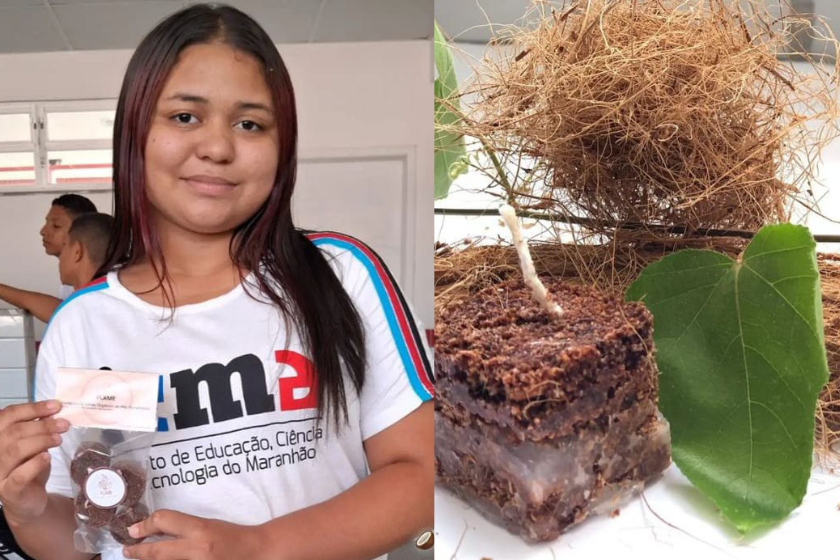In the northeast of Brazil, is Tutóia, a municipality with urban beaches where a lot of coconut water is consumed. One of the most visited spots is the village of Arpoador, where coconuts are so abundant that they are even used to pave the streets. As it is a place where the soil has a lot of sand, the fruit peels serve to prevent vehicles from getting stuck. Observing the exciting potential for the sustainable use of this input, students decided to take advantage of it to generate low-cost fuel for residents.
The project, entitled “Produção de Combustível Sólido de Alto Rendimento com Cascas de Coco e Serragem” (in English, Production of High-Yield Solid Fuel with Coconut Husks and Sawdust), was one of the finalists of Solve For Tomorrow in 2023 in Brazil. The team members were in the 1st year of high school (the third to last year of compulsory education); they were between 14 and 15 years old, and studied in different areas of technical education: Administration, Nursing, Gastronomy, and Tour Guide.
According to chemistry teacher Lute Rafael de Souza, who mediated the project, the idea came about in an elective course at the school called “Made in Tutóia”, whose focus was learning how to use common materials in the region – such as shrimp, coconut and cassava – to develop new products. “This discipline ended up generating a huge brainstorm. The students found fertilizer and water filters made from coconut shells, plastic made from shrimp shells, etc. And we looked at what was most viable to develop a project and the idea of barbecue lights ended up standing out”, highlights Souza. This would solve the accumulation of coconut waste in the city and provide a more economical alternative for residents to use in their kitchens.
Initially, the goal was to make fire fuel similar to what was already on the market but using alternative materials and a portable size. To replace eucalyptus wood powder, they used coconut shells, grated with kitchen graters, and wood sawdust, obtained from sawmills in the municipality itself. However, the team did not know exactly what substance was used in the commercial product to combine the materials and produce the flame. On a hunch, they decided to use candle wax and it worked.
The lesson learned is that it is important to experiment in practice. When we put the prototype to burn and one of the students timed it, the flame lasted 18 minutes. I remember it as if it were yesterday, everyone celebrated, he recalls.
From coconut to fire
The team also developed burners in two formats: cylindrical, shaped like a toilet paper roll, and cubic, shaped like a wooden mold. “The strong point of our project is that it is easy to do. Anyone in the community, where there are a lot of coconuts, can grate the shell and mix it with candle wax, mold it, and make the material. This can even be a source of income for people”, he highlights.
With a single dry coconut, it is possible to produce 41 units of solid fuel. “The cylindrical format showed the highest performance, the average flame duration was around 27 minutes. It’s an intense flame, with an elevated temperature, reaching close to 700 °C,” he highlights.
In addition to being a lighter, the product can also be a repellent
Based on the success of the first experiments, the team continued to think about how to add new functions to solid fuel. One of the students had the idea of adding repellent properties to the product since it is a region that has a lot of mosquitoes at night. To do this, they used the burning of another common species in the region: Indian neem. Livestock farmers use the plant to knock off animal ticks. Furthermore, the smoke from the burned coconut shell itself is widely used as a homemade repellent to scare away insects.
“We dehydrate the neem leaf with the prototype of another project, which is a solar oven. From these dehydrated leaves, we mixed them with coconut shell powder and tested some variations. First, we experimented with the fuel burning and the repellent effect was not very great. But, if you let it burn for a few minutes, turn it off and just let the smoke spread throughout the room, the result is particularly good for repelling mosquitoes”, explains Souza.

Future in Science
The mobilization of students to develop the project was voluntary and one of the most important results observed by the teacher was acquiring a taste for science and autonomy. For Souza, the purpose of doing science is to seek solutions to help people in real life. “These students are no exception to anyone at university developing a project with a scientific initiation scholarship. They were extremely punctual with our lunch break schedule. They showed maturity, responsibility, protagonism, and organization”, praises the teacher.
For the educators at IEMA Casemiro de Abreu, the project approved by Solve For Tomorrow brought new enthusiasm to believe in the transformative power of education. “Participating in a program of this size is such a unique privilege, it is something that will mark my life forever. Through Science, Engineering, and experimental approaches, we can motivate students. Today, I’m super motivated. And I’m sure this encouraged the entire school team,” he reports.



